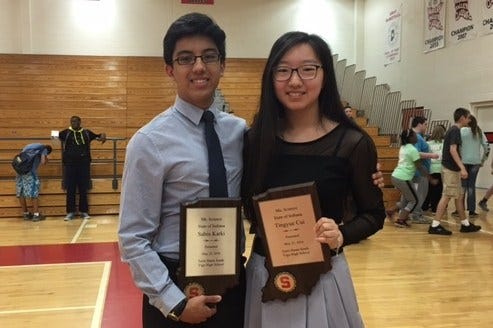South Vigo Students Win Mr., Miss Science—Again
 Sabin Karki (left) will attend Johns Hopkins University
Sabin Karki (left) will attend Johns Hopkins University
Subscriber Benefit
As a subscriber you can listen to articles at work, in the car, or while you work out. Subscribe NowAt only 18, Mr. and Miss Science have harnessed the power of supercomputers, conducted work that’s earned prestigious international awards and even endured the drudgery that comes with deep research. Tingyue “Rita” Cui and Sabin Karki—named the top two science students in the state by the governor’s office—also shine a spotlight on the science department at Terre Haute South Vigo High School, where they both graduated from just weeks ago. In the nine years the award has existed, South Vigo students have claimed it four times, and this marks the first time Mr. and Miss Science have both hailed from the same school.
“It could be the water,” laughs South Vigo Science Department Chair Melanie Huber. “I think it’s just the tremendous science program. We also have tremendous support from the entire Vigo County School Corporation. It’s interesting to note, Vigo County is one of the poorest areas in the state of Indiana—we’re a service-oriented community.”
Vigo County’s poverty rate is the eighth-highest in the state, meaning faculty, teachers and parents have greatly supported the financial demands of sending South Vigo students to national and international science fairs and competitions to sharpen their skills. Huber says many bake sales and pizza sales have paved the road to competitions; a recent faculty “jeans day” raised $1,000.
“When I went to the [Intel International Science and Engineering Fair], I met kids who went to Carmel [High School] and schools that are much richer and have many more resources than we do here,” says Karki. “And I thought, ‘We can’t win an award like Mr. Science here.’ But we did, and that’s a testament to the faculty here.”
South Vigo’s 14 science teachers, however, are quick to credit the diligence of students like Karki and Cui for making the school stand out. Karki, for example, recalls his first research project that taught him the stick-to-itiveness of science; he visited local farms to test livestock fecal matter for a project on antibiotic resistance.
“That was not very fun; it was the middle of the winter, and I’m going to farms, running from pigs and picking up poop and plating it,” says Karki. “But the satisfaction I got when I was recognized for that [research] and won awards—it really kindled my love of science and pushed me to continue doing research for three years after that.”
The project was funded by an Indiana Academy of Research Grant, just one of many achievements in Karki’s high school career. In addition to presenting bioinformatics research at the 2015 Intel International Science and Engineering Fair, he also travelled to Nepal—where his parents are from—to conduct cervical cancer research.
He says his father, who is a physician, has helped provide context for the science he’s learning and taught him the importance of helping people. Karki will attend Johns Hopkins University in the fall, where he plans to study biomedical engineering and eventually earn a dual MD/MBA degree.
Miss Science will go to Harvard University in the fall, where she wants to explore what area of science interests her most, although she’s been bitten by the chemistry bug. She’s at her best, perhaps, manipulating molecules; using supercomputers at Indiana State University, she conducted computational chemistry projects.
“I can see these molecules and manipulate them in a virtual environment. After I conduct computational research, I can go into a lab and conduct experimental chemistry to either validate my hypothesis or disprove it,” says Cui. “I think it’s very interesting to use two different methods to examine the same subject.”
Cui placed third in chemistry at the Intel International Science and Engineering Fair, where she competed against more than 1,000 students from 70 countries and—similar to Karki—questioned her roots.
“I thought since I came from such a small area in Indiana that I really didn’t have a chance against anyone,” says Cui. “When I found out I won third place, it really validated my efforts.”
Both Karki and Cui acknowledge the Mr. and Miss Science award as the capstone of their high school academic careers and proof that being from a small area doesn’t limit your ability to achieve big.
Huber says Cui and Karki have been tremendous and cheerful students.
Cui says she tries to encourage young girls not to be intimidated by science.
Karki visited Nepal during his sophomore year to help collect and study data related to the republic’s cervical cancer burden.

